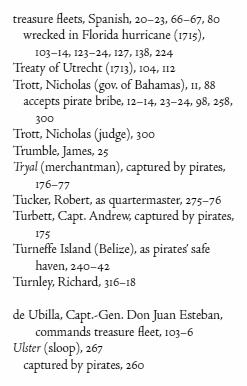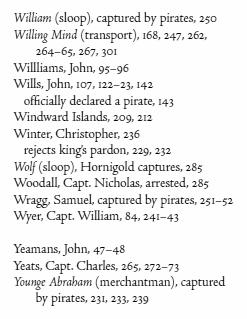The Republic of Pirates: Being the True and Surprising Story of the Caribbean Pirates and the Man Who Brought Them Down (63 page)
Authors: Colin Woodard








* Buccaneer is an imprecise term referring to the pirates and privateers who operated out of the West Indies in the seventeenth century, particularly in the 1670s and 1680s. The word originally referred to bands of lawless men, most of them French, who roamed the island of Hispaniola, hunting wild cattle and drying the meat on a
boucan,
an Indian-style meat-smoker; in addition to cattle, they occasionally hunted small vessels. The English later adopted the term
buccaneer
to refer to maritime raiders in the Caribbean in general, though this was not how the word was used at the time.
***
* As later discussed, this author was not Daniel Defoe, as asserted by generations of well-intentioned scholars and librarians.
***
† Most Catholic nations adopted the Gregorian calendar in 1582, when the two systems were ten days apart. By 1700, the discrepancy had widened to eleven days, where it remained until 1752, when Britain finally adopted the new calendar.
***
* Also spelled "Every" or "Evarie" in documents from the period.
***
* In 1962, the Bahamian legislature renamed it Paradise Island at the request of American supermarket tycoon Huntington Hartford. It is now taken up by luxury resort hotels.
***
* An island now split between the nations of Haiti and the Dominican Republic.
***
* Renamed Robinson Crusoe Island in 1966 by the Chilean government.
***
* The Town House (1713) still stands today, surrounded by skyscrapers, and is known as the Old State House. King Street is now known as State Street. The tidal flats that Long Wharf once traversed have been filled in to make the Boston waterfront.
***
† Andrew Faneuil, for whom Boston's famed Faneuil Hall is named.
***
* Young Sarah Walker (c. 1700–1731) would eventually marry William Fairfax, for whom Fairfax County, Virginia is named. Her daughter, Anne, was George Washington's mistress, a particularly awkward situation as she was married to his brother, Lawrence Washington. Anne's own brother, George Fairfax, apparently had some African features; he suffered humiliation during a childhood visit to England when his paternal relatives began speculating aloud as to whether his skin would turn black at puberty.
***
* For consistency, all dates in this book correspond to the Julian calendar that was then in use in Great Britain. Spain (and France) were already using the modern Gregorian calendar that, during this time period, was eleven days ahead of the Julian, meaning that Spanish documents record the 1715 treasure fleet departing on July 24.
***
*
El Grifon
arrived in Brest, France, on September 2 (of the Gregorian calendar), her passengers unaware of the fate that had befallen the fleet.
***
* This fort was completed in 1695 and survives today, entirely intact, the oldest masonry fort in the continental United States.
***
* Now adjacent to the city of Miami, but then next to an uninhabited marsh. At this time, there were no Spanish settlements between Cuba and St. Augustine.
***
* Today part of Indonesia.
***
* The "Island of Pines" later served as the model for Robert Louis Stevenson's
Treasure Island.
The second largest island in Cuba, it was renamed Isla de Juventud after the 1959 revolution.
***
* In reality, James Stuart had stayed for several weeks.
***
* No relation to Lord Archibald Hamilton.
***
* Captain Francis Hume of the
Scarborough
was actually looking for Bellamy and Williams, having responded to Governor Walter Hamilton's call to purge them from the Leeward Islands.
***
* Author of the play
Cato, a drama,
a source of many Libertarian ideas.
***
† For which the Kit Kat candy bar is said to be named.
***
‡ After his death, Sloane's collection would form the core of the British Museum.
***
* HMS
Swift
was capable of carrying eighty men and up to eighteen guns, most of them three-pounders, but only had six guns and forty men at Jamaica. She was a 128-ton sloop built in 1704.HMS
Seaford
was a large, 293- ton sixth-rate frigate with thirty-two six-pound guns.
***
* That is, not a Jacobite like Governor Archibald Hamilton had turned out to be.
***
* Then the principal port of French Hispaniola and now part of the nation of Haiti.
***
* Some writers have questioned whether this conversation, which was eventually published in
A General History of the Pyrates,
actually took place, asking who would have transcribed the conversation. The answer is Beer himself. After his audience with Bellamy, the captain was placed aboard the
Marianne,
where he had plenty of idle hours to record the historic conversation. He was released on Block Island a week or two later and, on April 29, showed up in Newport and reported what had happened to him to a correspondent of the
Boston News-Letter.
Details of the conversation were almost certainly recorded by Rhode Island authorities and forwarded to London, where they were made available to the author of the
General History.
***
* Williams needn't have worried. While cruising the Carolina coast in May 1716, the
Shoreham
ran aground on a reef, causing extensive damage to her keel and hull sheathing. She limped into Charleston on May 29, and wasn't able to return to sea for nearly a year. While Williams and Bellamy were prowling the Capes of Virginia, the
Shoreham
was still loading supplies in Charleston; she wouldn't arrive at Kinquotan (Hampton Roads) until May 1,1717.